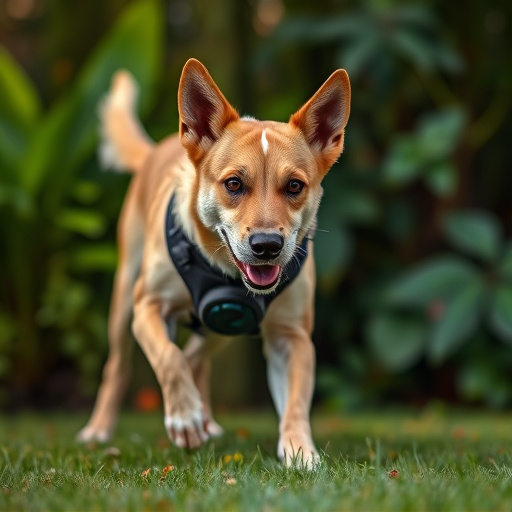Sound waves influence animal behaviors, with devices like the Maximum Range Ultrasonic Dog Repellent Device using high-frequency sounds (inaudible to humans) to deter pets, especially dogs, from unwanted areas or actions. Effectiveness varies based on environmental conditions, device quality, and individual dog behavior. However, ethical concerns arise due to potential distress caused by these sounds, prompting the exploration of alternatives like positive reinforcement training before using such repellents.
Sound wave pet behavior control is a fascinating and increasingly popular method aimed at modifying animal behavior through exposure to specific acoustic frequencies. This article delves into the science behind ultrasonic dog repellents, exploring how they utilize high-frequency sound waves to deter unwanted pet behaviors. We examine the maximum range of these devices, their effectiveness, and ethical considerations, providing a comprehensive guide for responsible use.
- Understanding Sound Waves and Their Effects on Animals
- The Science Behind Ultrasonic Dog Repellents
- Maximum Range: How Effective Are These Devices?
- Ethical Considerations in Pet Behavior Control
Understanding Sound Waves and Their Effects on Animals
Sound waves, invisible yet powerful, have a profound impact on animals. These pressure waves travel through mediums like air and water, reaching different species in varying ways based on their frequency and intensity. While humans primarily perceive sound through hearing, animals, especially those with more sensitive auditory systems, experience it as vibrations that can influence their behavior and communication.
When it comes to controlling pet behavior, particularly unwanted actions like barking or aggression, devices like the Maximum Range Ultrasonic Dog Repellent Device leverage this understanding of sound waves. These innovative tools emit high-frequency sounds beyond human hearing but are perceived as annoying or unpleasant by dogs and other animals. By carefully modulating these ultrasonic waves, such devices can effectively deter unwanted behavior without causing harm, ensuring a peaceful and controlled environment for both pets and their owners.
The Science Behind Ultrasonic Dog Repellents
Ultrasonic dog repellents are a popular choice for pet owners seeking non-lethal methods to deter unwanted behaviors. The science behind these devices revolves around sound waves and their effect on canine perception. Ultrasonic waves are high-frequency sounds beyond the human hearing range, but dogs can detect them clearly. These repellents emit a specific frequency, often in the 25-64 kHz range, which is unpleasant to dogs but generally harmless.
The maximum range of these devices varies, but many modern models can effectively cover areas up to 100 square meters or more. The ultrasonic waves travel through the air and create pressure variations that stimulate the dog’s eardrums, leading to discomfort or even mild pain. This stimuli triggers the dog to associate the area with an unpleasant sensation, thereby discouraging them from entering or staying in that space. Key factors in their effectiveness include frequency accuracy, sound intensity, and consistent usage to train the dog’s behavior.
Maximum Range: How Effective Are These Devices?
The effectiveness of maximum range ultrasonic dog repellent devices relies heavily on their ability to emit sounds within a specific frequency range that are unpleasant or disruptive to dogs, while remaining inaudible to humans. These devices operate on the principle that dogs, with more sensitive hearing than humans, will avoid areas where these high-frequency sound waves are present. The maximum range of such devices is a crucial consideration; they are designed to cover larger areas, making them suitable for outdoor use and multi-room settings.
While many pet owners report positive results, the overall effectiveness can vary based on several factors, including environmental conditions (such as wind or rain), the device’s quality and placement, and individual dog behavior and sensitivity. In ideal conditions, maximum range ultrasonic dog repellent devices can be highly successful in deterring dogs from specific areas. However, for persistent behavioral issues or larger properties, combining these devices with positive reinforcement training may yield better long-term results.
Ethical Considerations in Pet Behavior Control
The use of sound wave pet behavior control devices, such as the Maximum Range Ultrasonic Dog Repellent Device, raises important ethical questions. While these tools claim to offer humane and effective solutions for managing pet behaviors like barking or aggression, their impact on animals’ well-being is not always fully understood. The high-frequency sounds they emit can be distressing or even harmful to certain pets, especially those with sensitive hearing, leading to anxiety or panic responses. Moreover, the effectiveness of these devices varies widely based on factors like environmental conditions and individual animal behavior, making them a hit-or-miss solution.
Ethical use of such devices necessitates careful consideration of alternatives and a thorough understanding of an animal’s needs. Trainers and owners should explore positive reinforcement methods, consistent training, and environmental modifications before resorting to sound wave repellents. It’s crucial to balance the convenience of immediate behavior modification with the long-term health and happiness of pets, ensuring that any chosen method aligns with ethical guidelines for humane animal care.
Sound wave pet behavior control, particularly through maximum range ultrasonic dog repellent devices, offers a non-lethal and humane approach to managing animal behavior. By understanding sound waves and their effects on animals, these devices harness the science of ultrasonic repellents to create an effective barrier against unwanted pet behaviors like barking or roaming. While these devices have shown promise in various settings, it’s crucial to consider ethical implications and remember that they may not work for every animal or situation. As we continue to explore innovative solutions, ongoing research will help optimize their range and effectiveness while ensuring responsible and ethical use.
